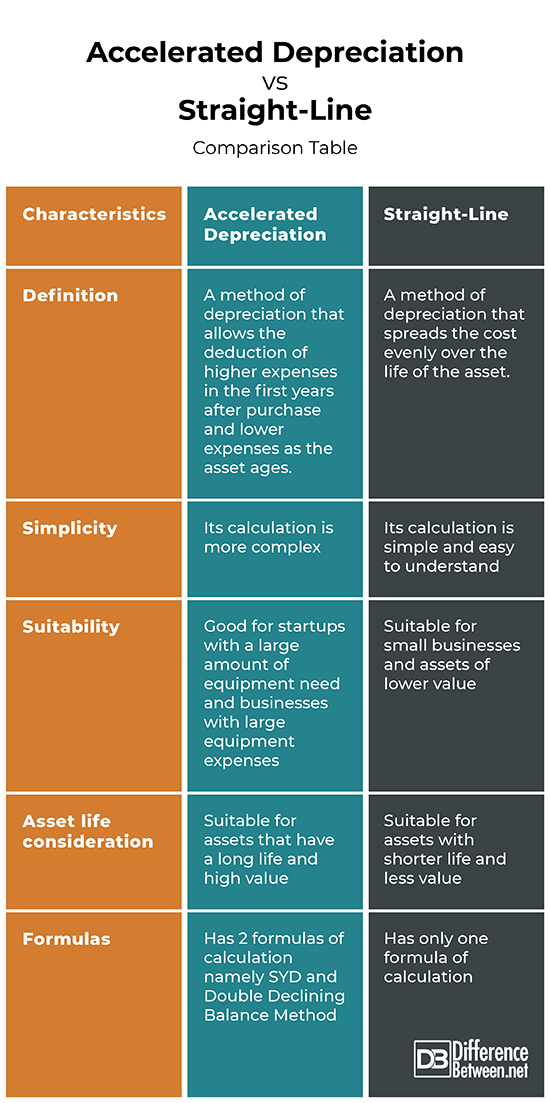Differences Between Accelerated Depreciation and Straight-Line
Depreciation in business refers to any kind of reduction in the value of an asset over time. The wear, tear, and usage of the asset cause it to lower its value. It is inevitable and is an expense to the business owner. Today we look at two types of depreciation namely accelerated Depreciation and Straight-Line Depreciation. Let’s find out their differences and get to know how you can apply each to your business.

What is Accelerated Depreciation?
Accelerated depreciation refers to a method used to calculate asset value over time. It’s based on the principle that an asset’s value is highest at the beginning of its lifespan. It, therefore, allows for more significant depreciation over these first years. It is used in accounting for tax purposes. It is a tax reduction strategy.
Accelerated Depreciation is best used by start-up businesses that need to purchase a large amount of equipment but want to offset the costs with tax savings. It’s also a good idea for businesses with large equipment expenses to keep up with business growth and expansion.
There are two methods to work out the accelerated depreciation:
- Sum of the Year’s Digit (SYD)
- Double Declining Balance Method
Sum of the Year’s Digit
Sum of the Years’ Digit’s Depreciation=Depreciable Cost * (Remaining Useful Life/Sum of Years’ Digits)
To calculate the Sum of Years’ Digits,
Sum of Years’ Digits= (Useful Life*(Useful Life+1))/2
Double Declining Balance Method
Double Declining Depreciation= 2*Straight-Line Depreciation Rate*Value at the Beginning of the Year
Benefits of Accelerated Depreciation
- It can help bring down a company’s taxable income in its early stages of growth. Normally during these stages, the income may be lower and asset expenses higher.
- It can also help offset some of the costs of business growth and expansion, encouraging business owners to reinvest in the business.
- Accelerated Depreciation is also a realistic way to track the value of an asset.
Disadvantages of Accelerated Depreciation
- There’s a risk of recaptured depreciation where if you sell your asset at a higher price than your accounting value, your profit is considered as recaptured depreciation. It is hence taxed as income.
- Its lower future deduction can be a problem for growing businesses.

Straight-Line Depreciation
Straight-line depreciation is a common method of depreciation where the value of a fixed asset is reduced evenly over its useful life. The method was developed to give a picture of the consumption pattern of the asset involved. It is generally used when there is no pattern on how you use an asset over time. It’s used to calculate tax deductions as well as for accounting purposes.
How to calculate Straight-Line Depreciation
This formula is used:
Straight-Line Depreciation= (Purchase Price-Salvage Value)/Useful Life
- The Purchase Price includes all the costs involved in the purchase and installation of the asset such as labor, transport, and taxes.
- The Salvage Value is the estimated cost of the asset at the end of its useful life.
- The useful life of an asset is an estimated or calculated number of years that the fixed asset is expected to be useful.
Benefits of Straight-Line Depreciation
- Simplicity
It’s the easiest method of depreciation to calculate.
- It’s also advantageous in that it results in fewer calculation errors.
- Assets can be written off completely
- Suitable for small businesses
- Useful for assets of lower value
Disadvantages of Straight-Line
- Does not have provision for replacement of assets
- It’s considered an illogical means of depreciation as it’s considered illogical to depreciate the asset on the original cost, yet the balance of the asset depreciates every year.
- Not useful for an asset with long life and high value
- Puts undue pressure on the asset’s final years (when all the repairs and maintenance are done) given that the depreciation is the same all through.
Similarities between Accelerated Depreciation and Straight-Line
- They are both methods of depreciation
- They are both used in the calculation of tax deductions and for accounting purposes.
Differences between Accelerated Depreciation and Straight-Line
Definition
The accelerated Depreciation method allows the deduction of higher expenses in the first years after purchase and lower expenses as the asset ages. Straight-Line Depreciation, on the other hand, spreads the cost evenly over the life of the asset.
Simplicity
Calculation of Accelerated Depreciation is more complex with while the straight-line depreciation is simple and easy to understand.
Suitability
Accelerated Depreciation is good for start-ups that need to purchase a large amount of equipment and also businesses with large equipment expenses while straight-line is suitable for small businesses and assets of lower value.
Asset life consideration
Accelerated Depreciation is suitable for assets that have a long life and high value while Straight-Line is suitable for assets with shorter life and less value.
Formulas
Accelerated depreciation has two formulas of calculation namely: SYD and Double Declining Balance Method while Straight-Line has only one formula.
Accelerated Depreciation vs. Straight-Line: Comparison Table

Summary of Accelerated Depreciation vs. Straight-Line
Both the Accelerated Depreciation and Straight-line are good methods of calculating asset value over time and are both used in tax deductions and for accounting purposes. Depending on your business and asset type you can choose which method to use. With this information, you will be able to make a wise choice between the two methods for your assets.
FAQS
Why would an airline choose an accelerated depreciation method over a straight-line depreciation technique?
Accelerated depreciation will help the airline take a higher reduction immediately hence reducing its current tax bill.
Why would you use accelerated depreciation?
It can help a business lower its taxable income in its early stages of growth.
Do companies prefer straight-line or accelerated depreciation?
Straight-Line Depreciation
Why is the straight-line method of depreciation called straight line?
It is because the depreciation amount is constant each year and so a graph of depreciation expense over time is a straight line.
What is straight-line depreciation?
Straight-line depreciation is a common method of depreciation where the value of a fixed asset is reduced evenly over its useful life.
- Difference Between Profit Center and Investment Center - July 2, 2022
- Difference Between Anti-Trust and Anti-Competition - June 6, 2022
- Difference Between Stocktaking and Stock Control - June 6, 2022
Search DifferenceBetween.net :
Leave a Response
References :
[0]United States. Congress. House. Committee on Ways and Means. Tax Reform: Administration and Public Witnesses. U.S. Government Printing Office, 2012. https://books.google.co.ke/books?id=2YM2jjZV6wEC&pg=PA3472&dq=Differences+between+Accelerated+Depreciation+and+Straight-Line&hl=en&sa=X&ved=2ahUKEwiukKDM6cf0AhWR2BQKHTXfCvwQ6AF6BAgHEAI#v=onepage&q=Differences%20between%20Accelerated%20Depreciation%20and%20Straight-Line&f=false
[1]Zee H & Tanzi V. Tax Policy for Developing Countries. International Monetary Fund, 2001. https://books.google.co.ke/books?id=6IbM6vkWI9gC&printsec=frontcover&dq=Differences+between+Accelerated+Depreciation+and+Straight-Line&hl=en&sa=X&ved=2ahUKEwiukKDM6cf0AhWR2BQKHTXfCvwQ6AF6BAgCEAI#v=onepage&q&f=false
[2]Mr.Victor Thuronyi. Tax Law Design and Drafting, Volume 1. International Monetary Fund, 1996. https://books.google.co.ke/books?id=ab4Q9tktrX0C&printsec=frontcover&dq=Differences+between+Accelerated+Depreciation+and+Straight-Line&hl=en&sa=X&ved=2ahUKEwiukKDM6cf0AhWR2BQKHTXfCvwQ6AF6BAgLEAI#v=onepage&q&f=false
